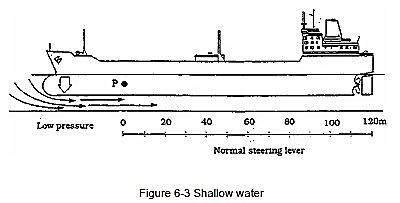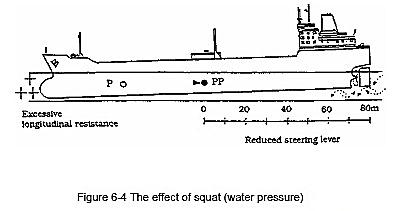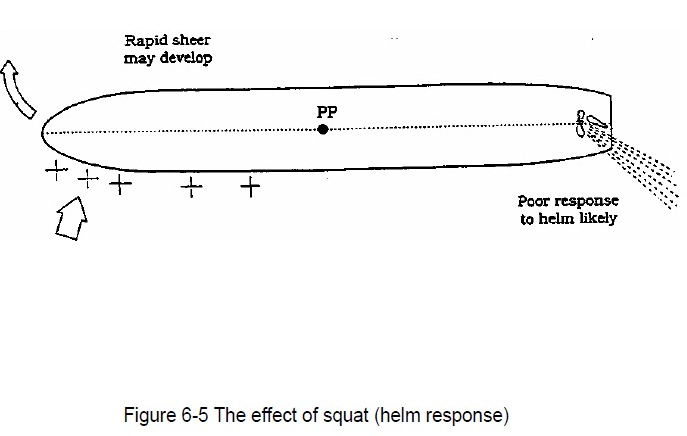Description Method of Calculation & Application:
- In figure 6-3 the ship is running on even keel with a small under keel clearance and, therefore, water which would normally pass under the ship is now severely restricted.

This result in two things, firstly the build of water ahead of the ship, longitudinal resistance pushes the pivot point back from P to PP and the steering lever is reduced. Secondly the water being forced under the bow, at a higher speed than normal, creates a low pressure and loss of buoyancy. The ship will now ‘Squat by the Bow’ which in turn makes the problem even worse. Several cases have been reported of large ships running in shallow water and experiencing bow sinkage of up to 2 metres!

In addition to the possibility of grounding forward there also exists the possibility of losing control and sheering violently out of a channel. If the helmsman allows a small swing to develop, longitudinal resistance ahead of the ship will be brought round onto the exposed bow, (as in figure 6-5) which in turn will encourage a violent swing in the same direction as the helm. Counter helm to correct the swing may be sluggish because as we have seen, the steering lever is reduced. Once the ship does respond, it may now sheer violently the other way. A chain reaction then sets in, with the ship sheering badly from one side to the other and failing to respond correctly to the helm. The effect can be extremely rapid, with the ship out of the channel and aground in just a few minutes. Excessive speed is the main contributing factor under such circumstance; reduced speeds are essential to avoid such violent forces building up.

- Trim is also important and in some districts the pilotage authority may refuse to handle certain ships if they are trimmed by the head and may even request a small trim by the stern. The latter does, in any case, improve the steering lever and therefore the handling of a ship, it may also be intended as an allowance for squat by the bow and very much a decision based upon local knowledge and experience.
Effect:-
- Water displaced by the hull is not easily replaced.
- Bow wave and stern wave increase in height.
- Trough becomes deeper and after part is drawn downwards.
- Under keel clearance decreases.
Squat varies on the following factors:-
Ship’s speed: – Squat is directly proportional to the square of speed.
Squat a V2 (V = speed in knots)
Block co-efficient: – Squat directly varies with CB.
Squat a CB
Blockage factor (S):- it is the ration between cross section of the vessel and cross section of the canal or river. Squat varies with blockage factor as.
Squat a S0.81
So, in confined water, squat is more than in open water.
Squat may be calculated by the following simplified formulae:
Squat = (CB X V2) / 100 (In open waters)
Squat = 2 X (CB X V2) / 100 (In confined waters)


